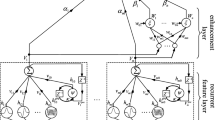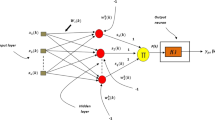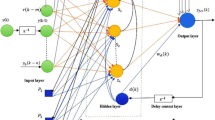Abstract
This paper proposes an adaptive recurrent neural network control (ARNNC) system with structure adaptation algorithm for the uncertain nonlinear systems. The developed ARNNC system is composed of a neural controller and a robust controller. The neural controller which uses a self-structuring recurrent neural network (SRNN) is the principal controller, and the robust controller is designed to achieve L 2 tracking performance with desired attenuation level. The SRNN approximator is used to online estimate an ideal tracking controller with the online structuring and parameter learning algorithms. The structure learning possesses the ability of both adding and pruning hidden neurons, and the parameter learning adjusts the interconnection weights of neural network to achieve favorable approximation performance. And, by the L 2 control design technique, the worst effect of approximation error on the tracking error can be attenuated to be less or equal to a specified level. Finally, the proposed ARNNC system with structure adaptation algorithm is applied to control two nonlinear dynamic systems. Simulation results prove that the proposed ARNNC system with structure adaptation algorithm can achieve favorable tracking performance even unknown the control system dynamics function.











Similar content being viewed by others
References
Lin CM, Hsu CF (2003) Neural network hybrid control for antilock braking systems. IEEE Trans Neural Netw 14(2):351–359
Peng YF, Wai RJ, Lin CM (2004) Implementation of LLCC-resonant driving circuit and adaptive CMAC neural network control for linear piezoelectric ceramic motor. IEEE Trans Ind Electron 51(1):35–48
Hsu CF, Lin CM, Chen TY (2005) Neural-network-identification-based adaptive control of wing rock motion. IEE Proc Control Theory Appl 152(1):65–71
Duarte-Mermoud MA, Suarez AM, Bassi DF (2005) Multivariable predictive control of a pressurized tank using neural networks. Neural Comput Appl 15(1):18–25
Hsu CF, Lin CM, and Lee TT (2006) Wavelet adaptive backstepping control for a class of nonlinear systems. IEEE Trans Neural Netw 17(5): 1175–1183
Lin CM, Hsu CF (2004) Supervisory recurrent fuzzy neural network control of wing rock for slender delta wings. IEEE Trans Fuzzy Syst 12(5):733–742
Tian L, Wang J, Mao Z (2004) Constrained motion control of flexible robot manipulators based on recurrent neural networks. IEEE Trans Syst Man Cybern B Cybern 34(3):1541–1552
Lin CM, Chen CH (2006) Adaptive RCMAC sliding mode control for uncertain nonlinear systems. Neural Comput Appl 15(3):253–267
Schaft AJ (1992) L 2 gain analysis of nonlinear systems and nonlinear state feedback H ∞ control. IEEE Trans Automat Contr 37(6):770–784
Lin CL, Lin TY (2002) Approach to adaptive neural net-based H ∞ control design. IEE Proc Control Theory Appl 149(4): 331–342
Wang WY, Chan ML, Hsu CCJ, Lee TT (2002) H ∞ tracking-based sliding mode control for uncertain nonlinear systems via an adaptive fuzzy-neural approach. IEEE Trans Syst Man Cybern B Cybern 32(4): 483–492
Lee TS, Lin CH, Lin FJ (2005) An adaptive H ∞ controller design for permanent magnet synchronous motor drives. Control Eng Pract 13(4):425–439
Lee SJ, Ouyang CS (2003) A neuro-fuzzy system modeling with self-constructing rule generation and hybrid SVD-based learning. IEEE Trans Fuzzy Syst 11(3):341–353
Huang GB, Saratchandran P, Sundararajan N (2004) An efficient sequential learning algorithm for growing and pruning RBF (GAP-RBF) networks. IEEE Trans Syst Man Cybern B Cybern 34(6):2284–2292
Lin CT, Cheng WC, Liang SF (2005) An on-line ICA-mixture-model-based self-constructing fuzzy neural network. IEEE Trans Circuits Syst I 52(1):207–221
Leung CS, Tsoi AC (2005) Combined learning and pruning for recurrent radial basis function networks based on recursive least square algorithms. Neural Comput Appl 15(1):62–78
Lin FJ, Lin CH, Shen PH (2001) Self-constructing fuzzy neural network speed controller for permanent-magnet synchronous motor drive. IEEE Trans Fuzzy Syst 9(5):751–759
Gao Y, Er MJ (2003) Online adaptive fuzzy neural identification and control of a class of MIMO nonlinear systems. IEEE Trans Fuzzy Syst 11(4):462–477
Park JH, Huh SH, Kim SH, Seo SJ, Park GT (2005) Direct adaptive controller for nonaffine nonlinear systems using self-structuring neural networks. IEEE Trans Neural Netw 16(2):414–422
Slotine J-JE, Li WP (1991) Applied nonlinear control. Prentice-Hall, Englewood Cliffs
Lin CM, Hsu CF (2002) Recurrent neural network adaptive control of wing rock motion. J Guid Control Dyn 25(6): 1163–1165
Wang LX (1994) Adaptive fuzzy systems and control: design and stability analysis. Prentice-Hall, Englewood Cliffs
Chen G, Dong X (1993) On feedback control of chaotic continuous-time systems. IEEE Trans Circuits Syst I 40(9):591–601
Jiang ZP (2002) Advanced feedback control of the chaotic Duffing equation. IEEE Trans Circuits Syst I 49(2):244–249
Hsu CF, Lin CM (2005) Fuzzy-identification-based adaptive controller design via backstepping approach. Fuzzy Sets Syst 151(1):43–57
Hsu CF (2007) Self-organizing adaptive fuzzy neural control for a class of nonlinear systems. IEEE Trans Neural Netw 18(4):1232–1241
Acknowledgments
The authors appreciate the partial financial support from the National Science Council of Republic of China under grant NSC 96-2218-E-216-001. The authors would like to express their gratitude to the reviewers for their valuable comments and suggestions.
Author information
Authors and Affiliations
Corresponding author
Rights and permissions
About this article
Cite this article
Hsu, CF. Adaptive recurrent neural network control using a structure adaptation algorithm. Neural Comput & Applic 18, 115–125 (2009). https://doi.org/10.1007/s00521-007-0164-0
Received:
Accepted:
Published:
Issue Date:
DOI: https://doi.org/10.1007/s00521-007-0164-0




